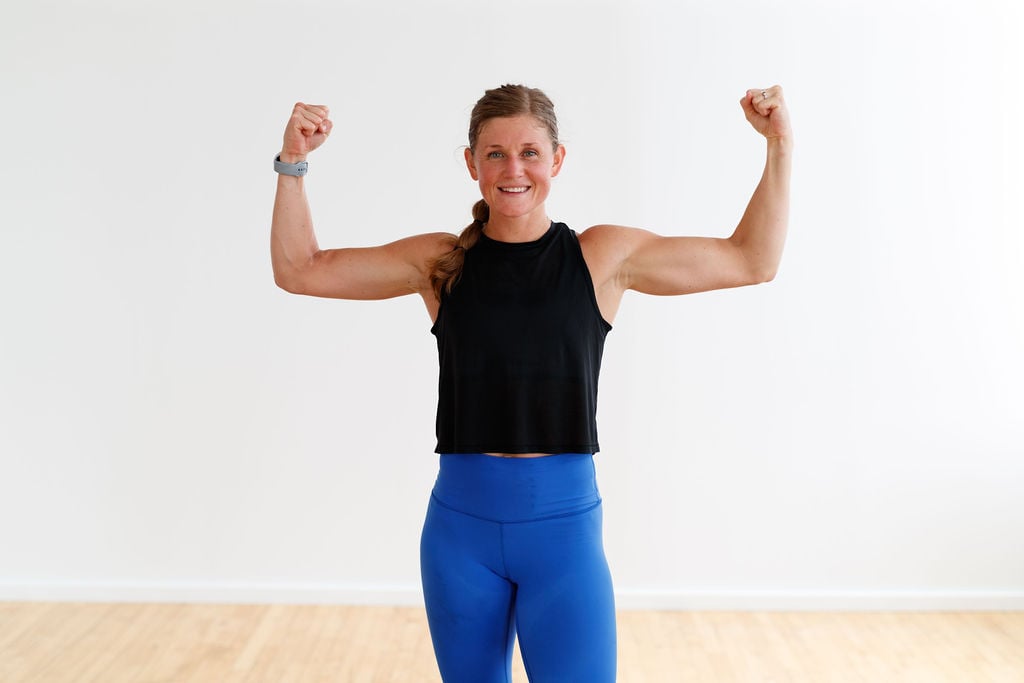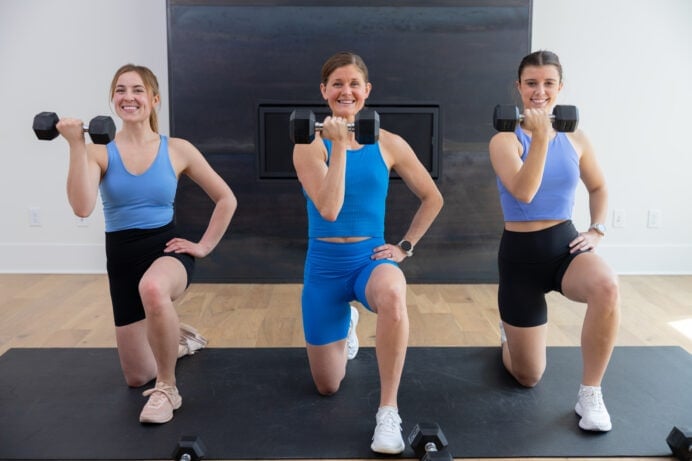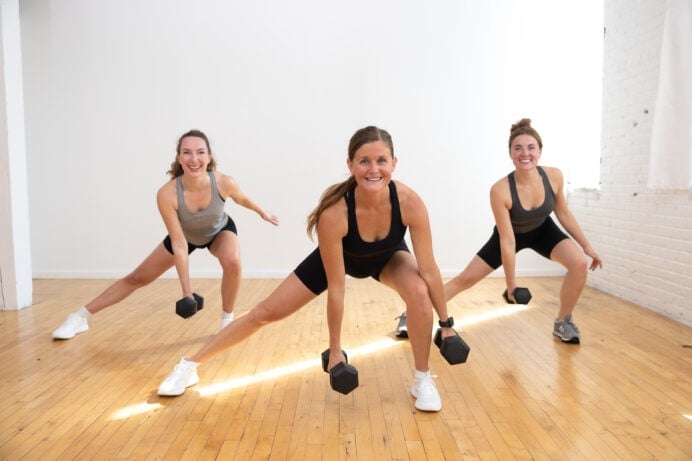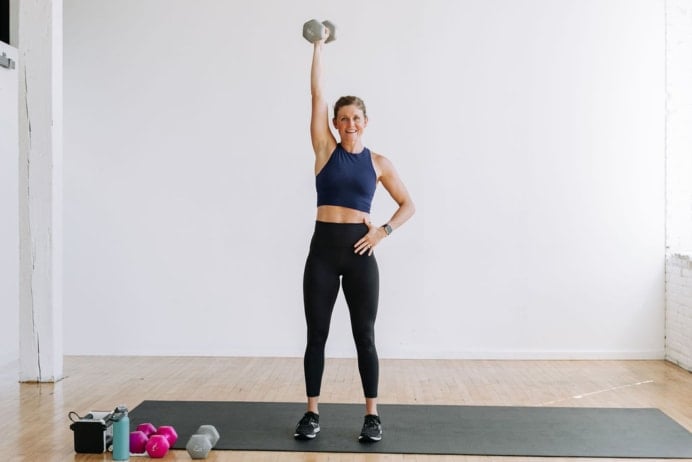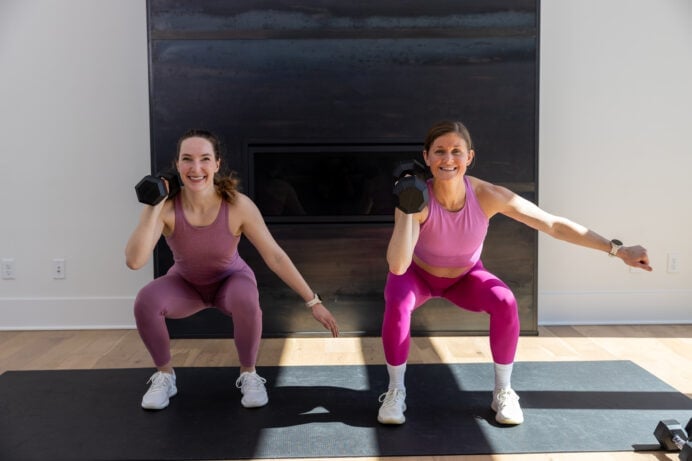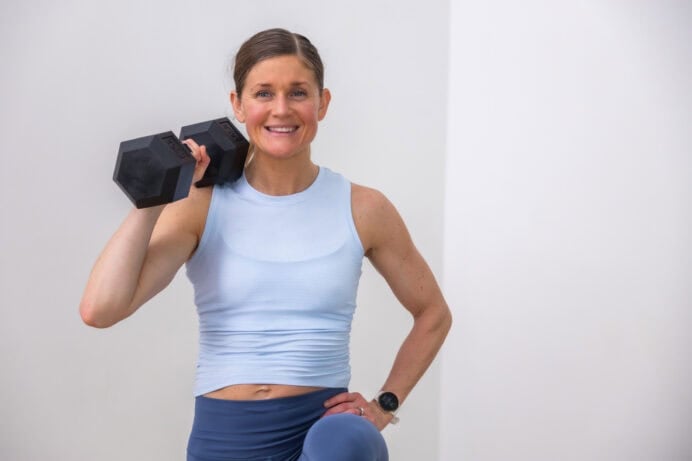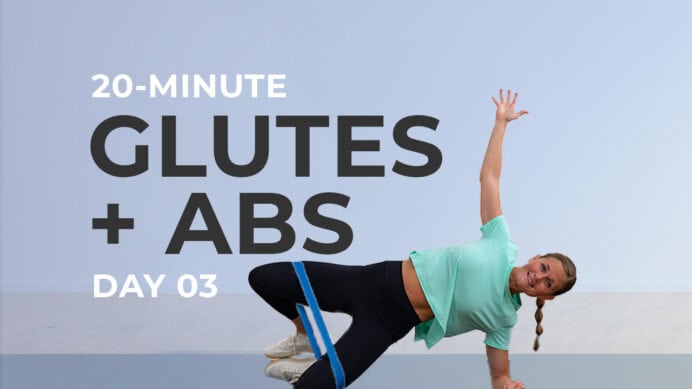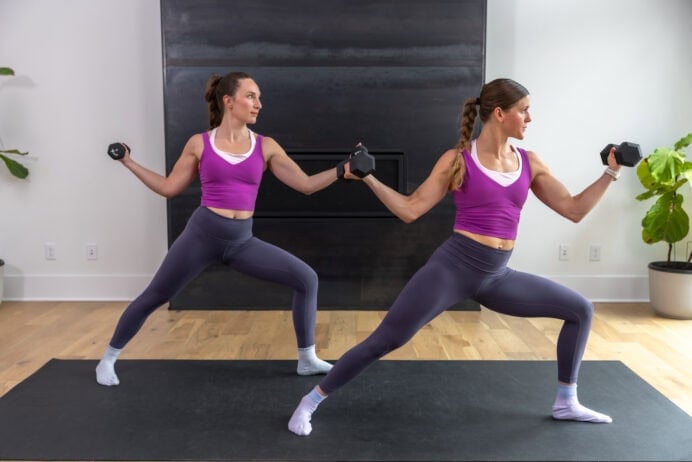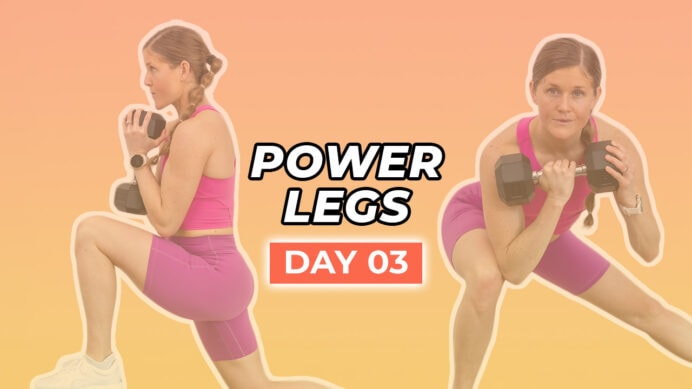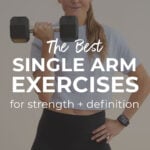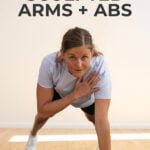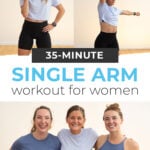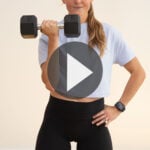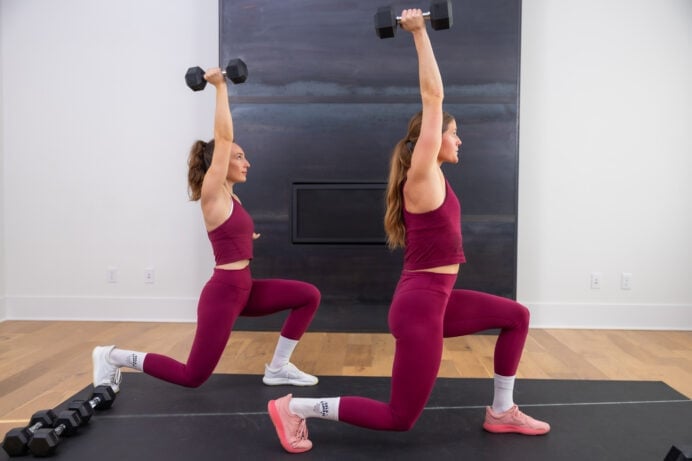
Unilateral Workout: 35-Minute Arms
Build strength in your upper body AND core with this unilateral arm workout! This upper body workout focuses on one arm at a time, allowing you to isolate each arm muscle and prevent muscle imbalances. This workout targets the biceps, triceps, chest, shoulders, back and core in around 30 minutes.
You loved our Unilateral Leg Workout and have been asking for an upper body version. Today’s arm day workout is ALL strength and made up entirely of single arm exercises.
Unilateral exercises allow us to isolate one side of the body at a time and work on reducing muscle imbalances between a dominant side and weaker side.
It also mimics many real-life motions such as reaching with one arm, carrying a load of groceries, or holding a baby on one hip.
As an added bonus, training one side of the body at a time increases core engagement and ab strength.
That means you get a challenging and effective upper body and core workout in around 30 minutes, using just a set of dumbbells.
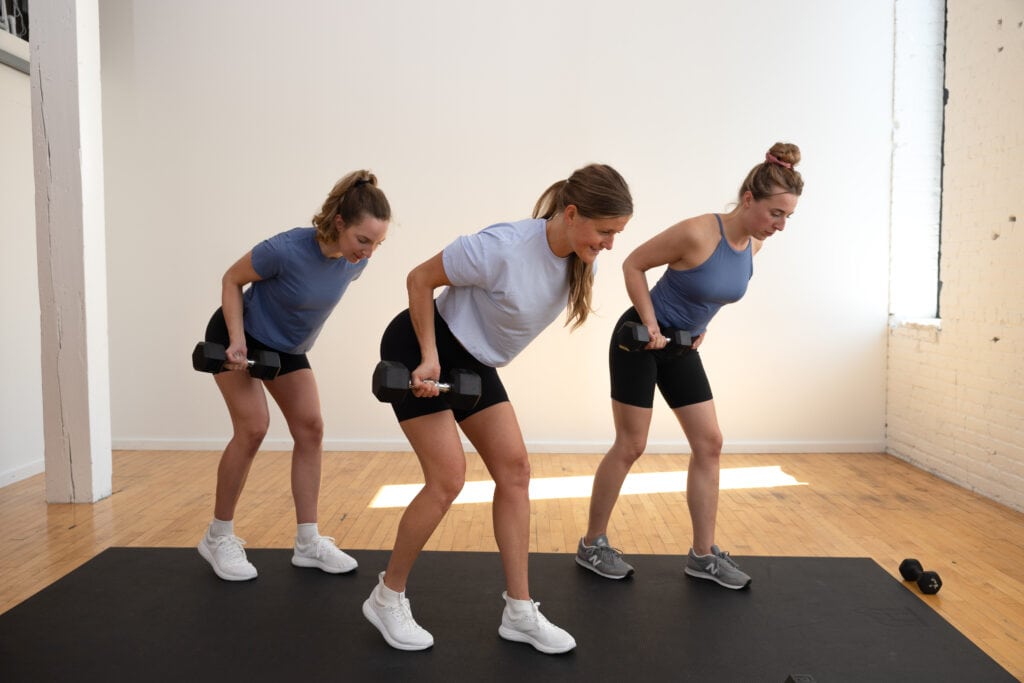
Unilateral Workout: 35-Minute Arms
Build a strong upper body and correct muscle imbalances with this all strength unilateral workout: upper body training! These are the BEST unilateral exercises for building muscle in the arms, back, shoulders and core.
Unilateral exercises recruit more muscles (specifically core muscles) than bilateral exercises. The abs and lower back are more engaged in single-arm exercises to help the body maintain balance.
Add this upper body workout to your home training program 1-2 times a week to build and maintain strength in the upper body.
Workout Equipment:
Medium Set of Dumbbells.
I recommend between 5-25 lbs depending on your fitness level. We used 10, 15 and 20 lb dumbbells in today’s workout. Option to drop weights at any time and do this workout with just your bodyweight.
Workout Instructions:
Follow along with the guided Unilateral Workout on YouTube, led by certified personal trainer, Lindsey Bomgren.
Your Workout Looks Like This:
- 3 Circuits (2 strength exercises and 1 arms and abs burnout exercise per circuit)
- Timed Intervals (30 seconds of work, 15 seconds rest; complete as many repetitions as you can in the timed interval)
- Repeat Each Circuit x4 Sets (x2 sets back-to-back on the right arm, then x2 sets on the left arm)
- Perform Burnout Move After Set 2 (Right Arm) and Set 4 (Left Arm)
Workout Outline
CIRCUIT ONE:
- Single Arm Chest Press
- Rotational Shoulder Press
Burnout: Uneven Push Up and Shoulder Tap
CIRCUIT TWO:
- Eccentric Single Arm Row
- Eccentric Single Arm Bicep Curl
Burnout: Single Sided Dead Bug and Dumbbell Pullover
CIRCUIT THREE:
- Kneeling Single Arm Overhead Tricep Extension
- Forearm Side Plank and Single Arm Dumbbell Pull
Burnout: Single-Sided Women Maker
6 Single Arm Exercises
Single Arm Chest Press
Targets: Chest (pectorals), shoulders (deltoids), core and triceps.
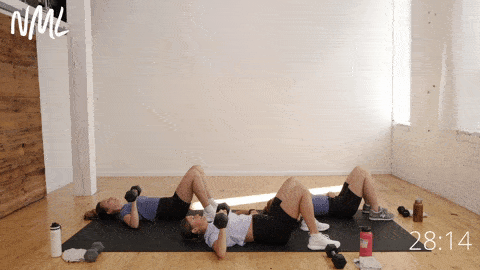
How To Do A Single Arm Chest Press
- Lay flat on your back with legs bent at 90 degrees. Hold one dumbbell in your right hand (palm facing knees), right elbow bent at a 90-degree angle.
- Exhale as you push the dumbbell overhead; dumbbell stacked over your right shoulder at the top of the press. Make sure your wrist is strong and in line with your shoulder.
- Lower the dumbbell back towards your chest with control.
Rotational Shoulder Press
Targets: Shoulder muscles (posterior, lateral, and anterior deltoids), core and obliques.
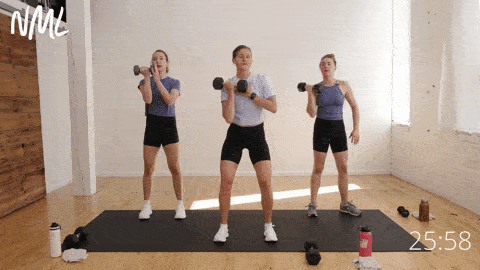
How To Do A Rotational Shoulder Press
- Stand with feet hip-width apart, toes pointing straight ahead, holding one dumbbell in your left hand at shoulder height, palm facing your body.
- Rotate your hips to the right as you press the dumbbell in your left hand overhead towards the right (rotational press). Note: the left foot should pivot, following the direction of the dumbbell.
- With control, bring the dumbbell back to your shoulder as you pivot, facing the front of the room to return to the starting position.
Modification: Take out the rotation, performing a single arm Arnold Press instead.
Eccentric Single Arm Row
Targets: The latissimus dorsi (or lats); largest back muscle. This unilateral exercise also engages the bicep and core.
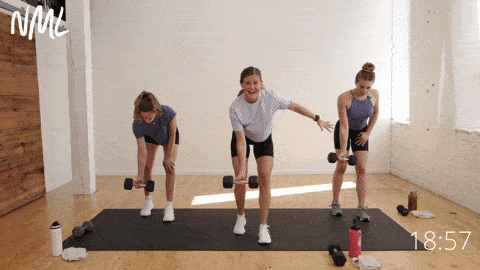
How To Do An Eccentric Single Arm Row
- Stand with your feet slightly wider than shoulder-width apart, knees slightly bent. Option to keep feet parallel or take a slightly staggered stance to better support your low back (stepping your right leg slightly behind your left leg).
- Hold a dumbbell in your right hand, palm facing out away from your body (reverse grip).
- Hinge forward at the hips maintaining a flat back, belly button pulled back towards your spine.
- Pull the dumbbell back towards your right hip (think of pulling from your elbow joint versus your wrist), as if you were starting a pull-start lawnmower. Stop once your elbow is in line with your rib cage, making a straight line from shoulder to elbow. Hold the row at the top for a moment squeezing your shoulder blade in.
- With control, lower the dumbbell back to the starting position and repeat. This is a slow deceleration of the weight through the full range of motion, lowering on a three-count in a controlled movement.
Eccentric Single Arm Bicep Curl
Targets: Biceps (front of the arm) and core.
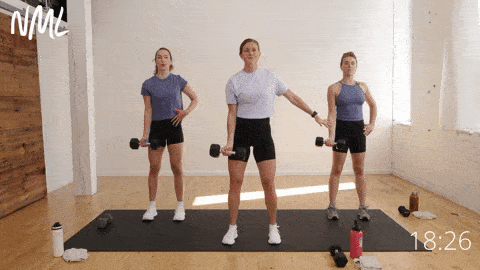
How To Do An Eccentric Single Arm Bicep Curl
- Stand with your feet slightly wider than shoulder-width apart, knees slightly bent.
- Hold a dumbbell in your right hand, palm facing away from your body.
- Keeping your right elbow locked by your side, squeeze your right bicep muscle to curl the weight up toward your right shoulder.
- With control, lower the dumbbell back to starting position. This is a slow deceleration of the weight through the full range of motion, lowering on a three-count in a controlled movement.
Kneeling Single Arm Overhead Tricep Extension
Targets: All three heads of the tricep muscle (lateral head, medial head, and long head) and core.
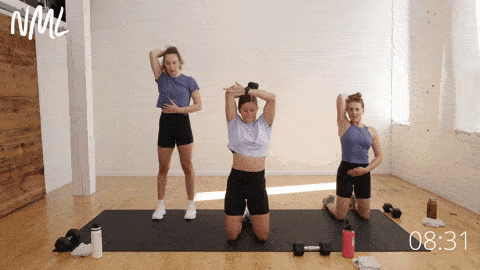
How To Do A Kneeling Single Arm Overhead Tricep Extension
- Start in a kneeling position, both knees on the mat with legs bent at 90 degrees, toes tucked under and core engaged.
- Hold a dumbbell in your right hand, arm extended and dumbbell stacked over right shoulder.
- Inhale as you lower the dumbbell with control, hiding the dumbbell behind your head. Focus on keeping your elbow in place (you can place your fingers on your elbow to keep it from moving).
- Then, exhale as you squeeze the back of your arm to extend the dumbbell overhead, returning to starting position.
Modification: Perform this exercise from a standing position instead of kneeling.
Forearm Side Plank and Single Arm Dumbbell Pull
Targets: The obliques, back, shoulders and core.
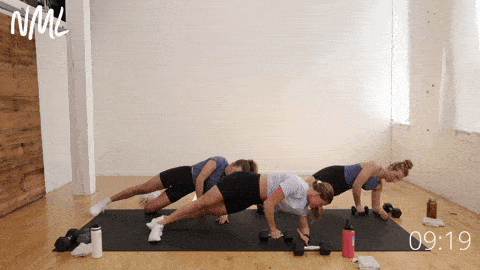
How To Do A Forearm Side Plank and Single Arm Dumbbell Pull
- Start lying on your right side. Place your right forearm flat on the ground, shoulder stacked over elbow. Stack your feet, left foot resting on top of right foot or staggering your feet. Place a dumbbell on the floor under your ribs.
- Hold this side plank position as you grab the dumbbell with your left hand and pull it overhead.
- Hold this position for a moment as your body mimics a sideways “T” shape.
- With control, slowly lower the weight, returning the dumbbell to the floor.
Modification: Bend your right knee at 90 degrees and place it on the mat underneath you to help support you. You can also perform this movement with just your bodyweight.
FAQs
Unilateral training is any type of exercise that focuses on one side of the body at a time. Popular examples of unilateral exercises include Bulgarian split squats, split lunges (or single leg squats), single arm presses, and single arm bicep curls. A bilateral exercise uses both limbs to perform a movement (such as a squat or chest press).
Unilateral exercises allow us to train both sides of the body equally. Unilateral training forces each single limb to do the work without allowing more dominant muscles to take over for the weaker side. Unilateral movements also turn on the muscles that surround the spine and core, increasing strength, stability and balance.
Yes, unilateral exercises are particularly helpful in correcting muscle imbalances and building a stronger core. Training one side of the body at a time forces the core to engage and stabilize – which mimics many of your everyday movements.
More Workouts
Strength WorkoutsPin This Workout: Unilateral Training for The Upper Body
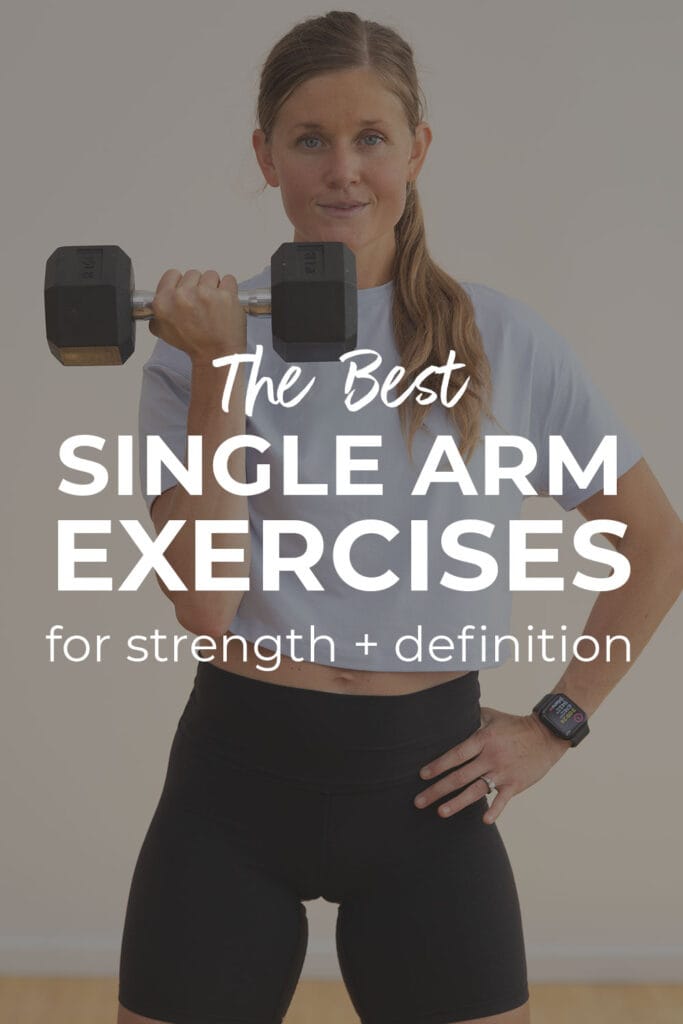
This post includes affiliate links. I do earn a commission for products purchased using these links (at no additional cost to you). Thank you for supporting Nourish Move Love, making the content you see on this blog possible.










